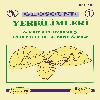Origin of vehrlitic intrusions in the Ispendere (Malatya) and Kömürhan (Elazığ) ophiolitic complex (Eastern Taurus-Turkey)
İspendere (Malatya) ve Kömürhan (Elazığ) ofiyolitik komplekslerindeki (Doğu Toros-Türkiye) verlitik intrüzyonların kökeni
___
- Aktaş G. and Robertson A.H.F., 1990. Tectonic evolution of the Tethys suture zone in S.E. Turken: Evidence from the petrology and geochemistry of Late Cretaceous ans Middle Eocene extrusives. In. Symp. On ophiolite genesis and evolution of oceanic lithosphere, Geol. Soc, London, Special Publ., 311-328.
- Benn K. and Laurent R., 1987. Intrusive suite documented in the Troodos ophiolite plutonic complex, Cyprus. Geology, 15: 821-824.
- Benn K., Nicolas A. and Reuber I., 1988. Mantle-crust transition zone and origin of wehrlitic magmas: Evidence from the Oman ophiolite: Tectonophysics, v.151, 75-85.
- Beyarslan M., 1996. Kömürhan Ofiyolit Birimi'nin Petrografik ve Petrolojik İncelenmesi. F.Ü. Fen Blimleri Enst. Doktora Tezi (yayımlanmamış). 103pp.
- Beyarslan M., 1991.1 spendere (Kale -Malatya) Ofiyolitler'nin Petrografik Özellikleri : F.Ü. Fen Bilimleri Enst. Yüksek Lisans Tezi (yayımlanmamış), 57 pp.
- Beyarslan M. and Bingöl A.F., 2000. Petrology of a supra- subduction zone ophiolite (Kömürhan-Elazığ-TURKEY). Canadian Journal of Earth Sciences. Canada. 37:1411-1424.
- Bingöl A.F., 1986. Petrographic and petrologique characteristics of the Guleman ophiolite (Eastern Taurus-Turken). Geosound, 13114, 41-57.
- Boudier F. and Coleman R.G., 1981. Cross section through the peridotite in the Semail ophiolite, southeastern Oman mountains. J. Geophys. Res., 86: 2573-,2592.
- Boudier F.,Bouchez J.L., Nicolas A., Cannat M., Ceuleneer G., Misseri M. and Montigny R., 1985. Kinematics of oceanic thrusting in the oman ophiolite: model of plate convergence. Earth Planet. Sci. Lett., 75:215-222.
- Boudier F., Ceuleneer G., and Nicolas A., 1988. Shear zones, thrusts and related magmatism in the Oman ophiolite: Initiation of thrusting on an oceanic ridge: Tectonophysics, v.151,275-296.
- Dahl R., Juteau T., Boudier F., Nicolas A., Bouchez J.L. and Crambert S., 1983. Ophiolite des nappes de Semail (Oman): nouvelles donnes de terrain sur les parties plutoniques superieures des massifs de Rustaq etide Nakhl. Sci. Geol. Soc. Bull., Strasb., 36:35-59.
- Dilek Y., Moores E.M. and Ramsden T.W., 1990. Tectonic evolution of the Troodos ophiolite within the Tethyan framework. Tectonics, 9: 811-823.
- Dilek Y., Thy P., Moores E.M., Delaloye M. and Karson J.W., 1991. A magmatic extension and tectonic denudation in the Kızıldag Ophiolite, South Turkey: Implications for the evolution of Neotethyan oceanic crust. In: T.J. Peters et al. (Editors) Ophiolite. Ophiolite Genesis and the Evolution of Oceanic Lithosphere, Kluwer, Dordrecht, pp. 458-500.
- Ernewein M. and Whitechurch H., 1986. Les intrusions ultrabasiques de la sequence crustale de I'ophiolite d'Oman: un evenement temoin de V extinction d' une zone d'accretion oceanique? C.R. Acad. Sci. Paris, Ser. 2, 303:379-384.
- Ernewein M., Pflumio C, and Whitechurch H., 1988. The death of an accretion zone as evidenced by the magmatic history of the Sumail ophiolite (Oman): Tectonophysics, v 151,247-274.
- Juteau T., Beurrier M., Dahi R., and Nehlig P., 1988. Segmentation at a fossil spreading axis: The plutonic sequence of the Wadi Haymiliyah area (Haylayn Block, Sumail Nappe, Oman): Tectonophysics, Vİ51,167-197.
- Lytwyn J.N. and Casey J.F., 1993. The geochemistry and petrogenesis of volcanics and sheeted dikes from the Hatay (Kızıldağ) ophiolite, Southern Turken: Possible formation with the Troodos ophiolite, Cyprus, along fore-arc spreading centers: Tectonophysics, v.223, 237-272.
- Nicolas A.,1989. Structures of Ophiolite and dynamics of oceanic lithosphere : Dordrect, Netherlands, Kluwer, 367pp.
- Pallister J.S. and Hopson C.A., 1981. Samail ophiolite plutonic suite: field relations, phase variation, cryptic variation and layering, and a model of a spreading ridge magma chamber. J. Geophys. Res., 86:2593-2644.
- Pearce J.A., Lippard S.J. And Roberts S., 1984. Characteristics and tectonics significance of supra-sub auction zone ophiolites. Geol. Soc. London, Special Publication, 16, 77-94.
- Penrose Conference Participants, 1972. Ophiolites. Geotimes, 17,24-25.
- Rabinowicz M., Ceuleneer G. and Nicolas A., 1987. Melt segregation and flow in mantle diapirs below spreading centers: evidence from the Oman ophiolite. J. Geophys. Res., 92: 3475-3486.
- Robertson A.H.F., 1994. Role of the tectonic fades concept in orogenic analysis and its application to Tethys in the Eastern Mediterranean Region. Earth Science Reviews 37,139-213.
- Robertson A.H.F., 1998. 54. Mesozoic-Tertiary Tectonic Evolution of The Easternmost Mediteranean Area: Integration of Marine and Land Evidence. Proceedings of the Ocean Drilling Program, Scientific Results, Vol. 160. 723-782.
- Yazgan E., 1983. A geotraverse between the Arabian platforme and the Munzur nappes. Int. Symp. on he Geology of the Taurus Belt, Ankara. Field Guide Book, Excursion V.
- ISSN: 1019-1003
- Yayın Aralığı: 1
- Başlangıç: 1986
- Yayıncı: Çukurova Üniversitesi Jeoloji Mühendisliği Bölümü
Geochemistry of Plio-Quaternary volcanics around Yeniyapan (Akdağmadeni-Yozgat), Central Anatolia
Taner EKİCİ, Musa ALPASLAN, Akif YEŞİLTAŞ, Nazmi OTLU
Harmancık (Bursa) manyezitlerinin jeokimyasal özellikleri
Emin ÇİFTÇİ, Bülent YALÇINALP, Hasan KOLAYLI, Richard D. HAGNI
Yüzdürme-batırma test sonuçlarının kükürt oranına bağlı olarak matematiksel değerlendirilmesi
Madencilik sektörü ve finansal kiralama
Tefenni-Yeşilova (Burdur) arasındaki diyabaz dayklarının jeokimyasal özellikleri
Kerim KOÇAK, A. Rıza SÖĞÜT, A. Müjdat ÖZKAN, Adnan DÖYEN, Veysel ZEDEF, Fuat IŞIK
Kireçköy (Alpu-Eskişehir) civarı dolomitlerin oluşumu ve ekonomik önemi
İnce boyutlu tanelerdeki nemin yüksek santrifüj kuvvetler uygulanarak uzaklaştırılması
Erzurum-Horosan-Pasinler Bölgesi gravite verilerinin Andreev-Griffin yöntemiyle değerlendirilmesi
